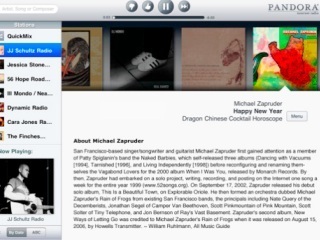

January marks the 11th birthday of Internet radio service Pandora and its future looks bright.
Earlier this month, rumors of an impending $100 million IPO began swirling through the blog circulatory system.
The company has yet to comment on the matter, but Reuters reports that the public offering could come as early as this spring. Pandora was reportedly meeting with bankers in bake-off meetings to get a feel for their options, CNBC reported last week.
But it hasn’t all been smooth sailing for Pandora. The company came close to being snuffed out on several occasions, and at one point, founder Tim Westergren reportedly considered organizing a company trip to Reno attempt to gamble their way into more money.
So how does a company go from nearly joining Napster in the gutter to a $100 million IPO? Answer: mobile.
Westergren, a Minneapolis-born pianist and composer, founded the company in January 2000 after working as a film composer and studying the framework of scores to determine what film directors would like.
The experience convinced him to start the Music Genome Project, which categorizes individual songs based on 400 different points of measurement, including things like the voice of the singer, beats per minute, and more.
Westergren successfully raised $1.5 million in angel funding and named his business Savage Beast Technologies, which initially functioned as a music recommendation service for larger companies like Best Buy and AOL. One year later, the company was broke and investors, devastated by the dot-com collapse, were reluctant to part with their money.
(Editor’s note: Tim Westergren will be a keynote at the Feb 3 Vator Splash event at Cafe du Nord in San Francisco. There’s still time to get early-bird tickets. Go to the registration page to reserve your tickets and see the agenda. These prices are good until next Monday!)
It wasn’t until 2004—a full three years later—that Westergren managed to raise more money (by then he had reportedly charged up eleven credit cards and was paying employees with IOUs). Larry Marcus, a VC with Walden Venture Capital, led a $9 million investment in the company, which ultimately paid for a management shakeup and goal realignment. Westergren handed over the chief executive hat to Joe Kennedy, who came to the company from E-LOAN. The company changed its name to Pandora and began to rethink its strategy. Instead of delivering its service to other businesses, the reborn Pandora decided to take its music directly to listeners through personalized radio on the Web.
Subscribers began to sign on, but in 2007 the company hit another roadblock that threatened to bury it. The Copyright Royalty Board hiked the performance royalty rates for Internet radio by more than 100%, which would have effectively put Pandora out of business. “Left unchanged, these rates will end internet radio, period,” Westergren blogged. “The RIAA has effectively convinced this federal committee to establish rates that make online radio a non-viable business.” Tim Westergren urged Pandora listeners to write to their local congressmen to get the rates reduced, but he later told the New York Times that the company thought about pulling the plug.
Joe Kennedy later learned that Congress received more calls about Pandora than they had about the war in Iraq. The campaign worked and in 2009, royalty rates (though still higher than before) were reduced to a workable level.
But it was the company’s move into mobile that really shot it off the map. In 2007, the company launched Pandora for Sprint and Pandora for Sonos, merging personalized radio with on-the-go mobility so that users could—for the first time—listen to Pandora without the need for a computer. In 2008, Pandora launched an iPhone app and subscribers skyrocketed. The company’s listenership doubled as 35,000 new listeners were subscribing to Pandora each day to stream their personalized radio from their phones, which only makes too much sense. Finally, you could listen to your own personalized radio on the treadmill, or while you walked your dog.
And Westergren insists that it won’t kill your bank account. “AT&T has a data plan with a 2GB limit and your average Pandora user consumes less than 10 percent of 2GB. Pandora streams very efficiently so it doesn’t use up too much bandwidth,” he told Reuters Thursday.
In 2010, Pandora announced that drivers will now be able to stream their Pandora stations in their car using the Ford Sync system, which would make streaming as easy as giving your car a voice command to launch a particular station.
The company’s move to mobile was clearly the force that catapulted it to stardom. Today the company has 75 million registered users, compared to 6.9 million in 2007, and is adding three million new users each month, with half of those new users subscribing on a mobile device. The company says that more than half of all the music streamed from Pandora is streamed via a non-PC device, and the Pandora App has seen 50 million downloads to date.
(To watch Tim present, be sure to join him at Vator Splash on February 3.)
Image source: sonicweekly.com


















